10 questions with...Out and Out Original
In our interview series, we talk to our favourite bloggers and experts about their trend predictions and styles. Here, we meet Daniel Fairburn
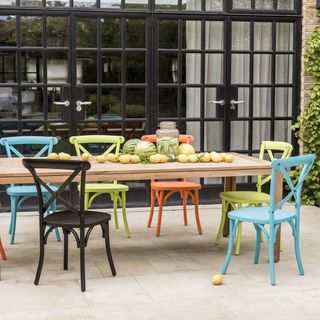
1. What is the best way to protect garden furniture from the elements?
Caring for your garden furniture very much depends on the items that you invest in to begin with as the qualities of each material will dictate the care needed. If you are a nature lover and opt for a wooden garden set, although expensive, it’s best to opt for teak if you can as it contains natural oils and tannins which protect it from wood rot and the elements. If your budget doesn’t stretch that far then chunky Eucalyptus wood designs are a beautiful alternative but try to get furniture covers to protect the wood when the weather turns. I’d really recommend avoiding cheaper woods, untreated pine or acacia as these are not very dense and are prone to splitting, warping and even cracking.
For a modern garden aluminium furniture is ideal and offers a maintenance free solution as it’s corrosion-free and simply needs wiping down every now and then. Similarly for a maintenance-free but slightly more traditional feel then Poly-Rattan is fantastic.
Where you choose the modern or natural look, it’s best to start each new summer season with a thorough wipe down and spruce up to get your garden looking tip top in time for the sunshine. A little TLC and you’ll be able to enjoy your garden furniture for years to come.
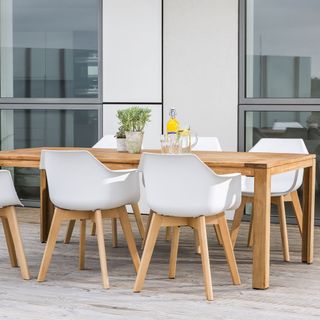
2. What are the difference between wicker and rattan furniture?
There is no difference, wicker and rattan are both terms used to describe a pliable, natural fibre which can be woven into a shape, such as furniture.
3. How can we get our garden summer ready?
Get the Ideal Home Newsletter
Sign up to our newsletter for style and decor inspiration, house makeovers, project advice and more.
Aside from the care and TLC you should give your garden furniture that I mentioned earlier, it’s worth even the most reluctant of gardeners taking the time to get their surrounding gardens, lawns and patios in check so you can fully enjoy your outdoor space all summer long.
If you have plenty of greens make sure you feed your lawn regularly so it is healthy and hydrated ready for the upcoming dry summer heat, and why not edge it at the same time. For those modern patios, grab a power washer and get it nice and clean – the winter weather can take it’s toll, leaving grubby residues and mossy areas that will make the garden look dirty, even on the sunniest of days.
Apart from those obvious points, the one that most people forget is to buy a large cantilever parasol, not to protect you from the rain but to protect you from the sun – once the sun comes out the good quality parasols normally sell out quickly!
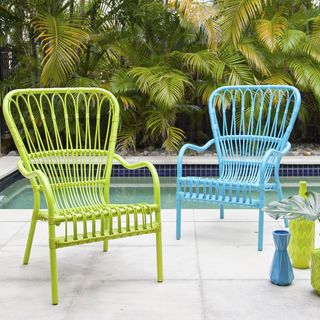
4. Do you have any useful tips for amateur gardeners?
Spend lots of time researching your options and make sure you make the right choice that fits. Whether that’s for the garden furniture that suits your needs, or those tropical plants you’ve had your eye on - we are all busy so make sure you have the time to keep up to whatever garden features you are looking to incorporate
5. Do you have any cleaning and maintenance tips that you can share with us?
Although it often requires maintenance, my favourite outdoor material is wood. I have a beautiful teak garden set at home that I’ve had for years – nothing beats kicking off the summer months with a day in the garden getting the furniture back to its best. Sanding back teak to its untouched grains and then applying bees wax for me is the most beautiful finish possible.
6. What style of garden furniture do you recommend for small gardens or patios?
Naturally where space is a premium, opt for small formats as well as folding or stacking designs. I’d opt for a designer wooden set with a fitted furniture cover to protect it in the winter.
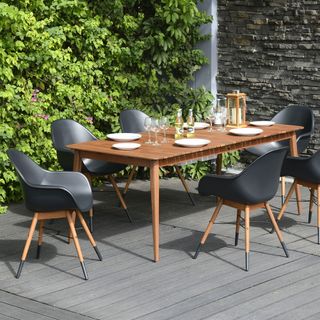
7. Wooden garden furniture is a natural choice for many. What is the most suitable wood?
One answer. Teak. There are other highly dense woods out there however, teak is the only one that is available as a sustainable, environmentally friendly option. The Forest Stewardship Council (FSC) has done a marvellous job in getting the big Indonesia plantations sustainable and eco-friendly. The wood itself is beautiful and, with the right care will last you for years to come. Whether you like the restored and maintained fresh look, or you prefer to let your teak age a little and take on a beautiful silvery colour, it’s a solid choice that will last perfectly well through our British winters.
8. What type of materials do you recommend for outdoor cushions etc?
Unless you opt for marine grade leather, there is no affordable “outdoor” material for cushions as the fabric is not the issue, it’s the cushion filling which absorbs water and causes mould and degradation of the cushions. Poly-Olefin fabrics are a combination of polyester and resin, interwoven, which offer water resistance but not repellence. Water repellent fabrics don’t breath, making the cushions uncomfortable so I would opt for a water resistant fabric which is shower proof and just make sure to bring the cushions inside when the weather turns.
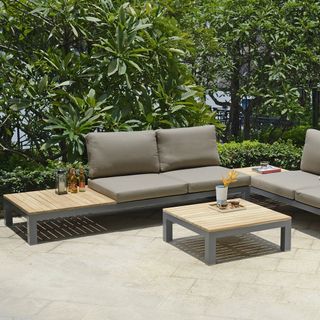
9. What garden trends have you seen coming through for 2017?
The garden is really starting to be seen as an extension of the home, meaning garden furniture is taking on a much more ‘design’ edge… for Summer we have a range of striking contemporary styles that could easily work for indoors or out. Additionally combination materials play a large part for 2017; using wood and resin or wood and aluminium together to create, lighter, more modern designs. Much more white and teak combinations which is refreshing after so many years of poly-rattan fever.
10. Have you ever had an epic gardening disaster?
I decided to landscape my back garden in Leeds (my home city) and started to dig up the lawn in order to terrace it with railway sleepers. Once under the top soil I realised that in a different life, the back garden had been a dumping ground for rocks from a nearby clay quarry. It was full of shards and chunks of rock the size of cricket balls mixed in with semi-solid clay, which isn’t very fun with a shovel. It took a week to finish for something that should have been done comfortably in 2 days.
Follow Out and Out Original on Twitter @OutOutOriginal
Jennifer is the Deputy Editor (Digital) for Homes & Gardens online. Prior to her current position, she completed various short courses a KLC Design School, and wrote across sister brands Ideal Home, LivingEtc, 25 Beautiful Homes, Country Homes & Interiors, and Style at Home.
-
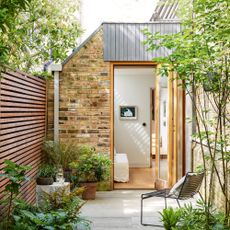 How to soundproof a garden - 7 ways to block out the noise
How to soundproof a garden - 7 ways to block out the noiseStuck with noisy neighbours? Busy road ruining your garden tranquillity? Here’s some effective ways to shut out the sounds
By Richard Jones
-
 The best kitchen island layout ideas for a sociable and practical cooking space
The best kitchen island layout ideas for a sociable and practical cooking spaceKitchen designers reveal the ideal kitchen layout ideas to make the most of every inch of space
By Holly Cockburn
-
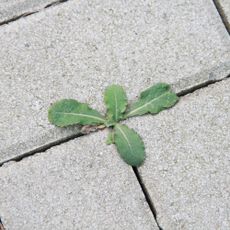 Does salt kill weeds? Absolutely, but gardening experts urge you to take note of these key considerations first
Does salt kill weeds? Absolutely, but gardening experts urge you to take note of these key considerations firstThe most effective way to use it for maximum impact
By Jullia Joson